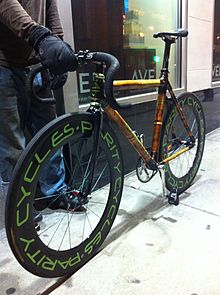Bamboo bicycle



A bamboo bicycle is a bicycle with a frame made out of bamboo. Custom built and manufactured bamboo bikes have become something of a trend, with producers in the United States, Latin America,[1] Asia,[2] and Africa.[3]
Some of the main features of bamboo designs are vibration damping,[4] crash tolerance,[4] and the natural look of the bike. Vibration damping is one of the most desirable features of such bikes. A bamboo bicycle can offer a very smooth and comfortable ride. As a result, bamboo has been made into road bicycles, mountain bikes, and racing bicycles.
Bamboo is also considered by some to be a more eco-friendly material than other more conventional frame materials.[3][5]
History
A bamboo bicycle was first showcased on April 26 in 1894.[6] A US patent was applied for in 1895, by August Oberg and Andrew Gustafson, and granted in 1896.[7]
Notable current manufacturers include FlavioDeslandes, Calfee Design,[4] and Biomega. A company in New York, which is a spin-off of the Bamboo Bike Project, offers weekend-long workshops in which participants can build their own bamboo bicycle frames.[8]
Technical aspects
Different methods exist to treat the bamboo poles and make them durable. All methods aim to cure the material in order to improve durability. One company smokes and heat-treats the bamboo. Others use a torch to achieve the same effect. Ovens can also be used. To prevent water-damage the bamboo can be coated with a sealant such as polyurethane.
The bamboo poles can be joined in different ways. The earliest models used metal joints which were then tightened around the bamboo. Another approach is to wrap the joints with resin saturated fibers to make composite lugs around the bamboo frame members.
See also
References
- ^ "'Bambucicleta,' the bicycle made from bamboo canes". Buenos Aires Herald. August 2, 2011. Retrieved 2014-06-15.
{{cite web}}: Italic or bold markup not allowed in:|publisher=(help) - ^ Greg Jorgensen (2 September 2010). "Smooth rides for Bangkok's first bamboo bike owner". CNN Travel. Retrieved 7 October 2014.
- ^ a b "Ghana Bamboo Bikes Initiative". United Nations Framework Convention on Climate Change. 2014. Retrieved 2014-06-15.
- ^ a b c "Calfee Design: Bamboo bike". Archived from the original on 21 May 2010. Retrieved 2010-05-16.
{{cite web}}: Unknown parameter|deadurl=ignored (|url-status=suggested) (help) - ^ Jen Lukenbill. "Bamboo bikes". AboutMyPlanet. Retrieved 2010-05-16.
- ^ "Bamboo bicycles-110 years later". Archived from the original on 21 April 2010. Retrieved 2010-05-16.
{{cite web}}: Unknown parameter|deadurl=ignored (|url-status=suggested) (help) - ^ Tony Hadland and Hans-Erhard Lessing (2014). Bicycle Design, An Illustrated History. MIT Press. p. 176. ISBN 978-0-262-02675-8.
- ^ "Bamboo bike workshop".
External links
![]() Media related to Bamboo bicycles at Wikimedia Commons
Media related to Bamboo bicycles at Wikimedia Commons
